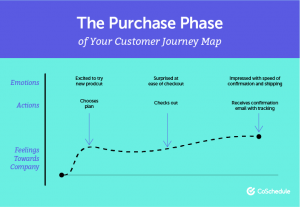— April 6, 2018
Online courses are rapidly growing in popularity. A GM insights report estimated the value of the e-learning market at $ 150 million in 2016 and predicts that it will cross $ 250 billion by 2024.
Launching your own online course can be a very profitable venture. However, there are several elements that you have to address before you can get started.
- How do you identify a niche that is profitable?
- How do you compete with other existing courses?
- How do you determine if people will buy your course – even before you create it?
- How do you easily set up the technology required to launch your course without wasting valuable time and money?
In this article, I will cover a simple five-step process for building an online course.
1. Identify the Niche
You have an interesting idea for a course, but how do you determine if there are enough people prepared to purchase it? The first step is to look for similar courses in your chosen niche.
Check Similar Courses
For instance, if you are planning to launch a language learning course, look for similar language courses by doing a Google search. You should also go through online course marketplaces such as Udemy.
Are there several similar courses? More importantly, are those courses popular?
Udemy displays the number of students enrolled in every course. That will help you gauge the level of interest in the market.
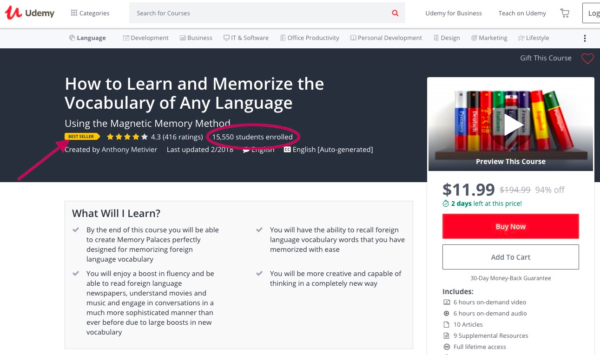
- Image source: https://www.udemy.com/language-learning-online-magnetic-memory/
If there are plenty of popular courses, that’s actually great news. If people are already buying courses on that topic, it means that there is a market for it.
On the other hand, if no one has even built a course on that topic, or if the existing courses have few customers, it’s an indication that the niche is likely not so profitable.
If that’s the case, you should look for similar niches that are profitable or a different niche altogether.
Finding Your Differentiation
Just because your niche already has several courses, doesn’t mean that it’s saturated with competition. You can be a player too. Compete by addressing gaps in other courses in these ways:
- Giving better solutions
- Addressing unanswered questions
- Making your course easier to learn
- Offering a better price
To understand how you can build a better course, you need to do a bit of research.
Let’s see how.
2. Identify Problems
People will buy your online course only if your content offers them compelling solutions to problems that are a major pain.
But what problems are your audience losing sleep over?
For example, if you want to create a course that allows students to learn French rapidly, you need to identify the specific roadblocks people are most frustrated about.
Here are a few ways to do that.
Udemy Reviews
Begin by looking at negative reviews of existing French courses on Udemy. These provide great insights into how you can create a competitive advantage with your course.
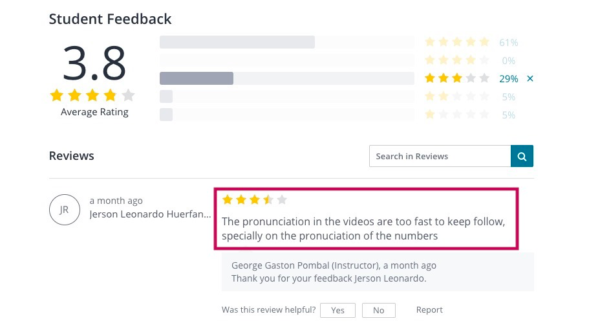
- Image source: https://www.udemy.com/my-first-french-course/
Amazon Reviews
Look for books in your niche and go through the reviews, especially the negative ones. What questions have those books not answered? How are people reacting to the solutions given?

- Image source: https://www.amazon.com/Vegetable-Gardeners-Bible-2nd-R-D/dp/160342475X
Quora and Reddit
Both of these platforms have vast, rabidly engaged communities. Search for common questions that people are asking, and look through the answers carefully.
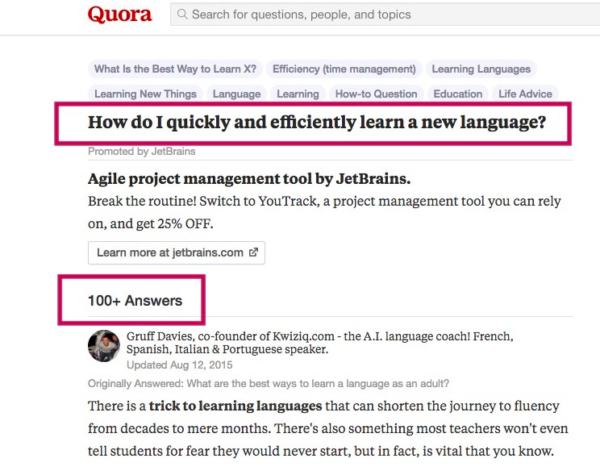
- Image source: https://www.quora.com/in/How-do-I-quickly-and-efficiently-learn-a-new-language
Google Search
Perform a Google search for keywords associated with your potential topic alongside keywords associated with learning, and go through at least a few dozen articles. Take down notes listing the different challenges people are writing about. Make sure you also read through the comments. They are a great source of information about people’s complaints.
Email List Surveys
If you’ve been blogging about your general topic for some time, then you may already have an email list consisting of interested people. Send out a survey via email asking for people’s specific knowledge gaps and learning challenges. If your blog is about entrepreneurship and you are thinking of launching a course about crocheting, you might not get the best responses from your email list. In that case, try the next step.
Facebook Surveys
Any meaningful survey should have at least 100 responses. If you don’t get as many from your email list, you can run a paid survey on Facebook.
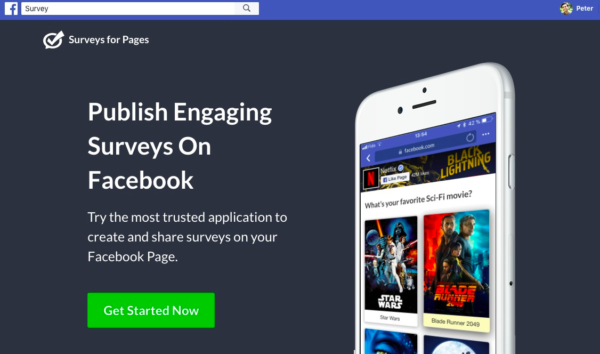
- Image source: https://www.facebook.com/simple.surveys/app/155008507867572/
Focus Group Interviews
Don’t just stop after the survey. Reach out to people who have given the most detailed responses and ask them to hop on a call to discuss their challenges in detail. Assure them that you won’t be selling them anything at the end of the call, and you will have plenty of people willing to share their thoughts with you.
3. Analyze and Refine
Now that you have a lot of data, it’s time to analyze it and turn it into a specific idea.
Look for Themes
Most of the challenges that you come across will fall into a few common themes. Pick two to five of the most common themes. Pay close attention to the problems that other courses are not addressing. Including them in your online course will be your competitive advantage over other courses.
Define the Scope of the Topic
Your topic can be narrow or broad. For instance, should you make a course about investing in stocks in general or investing specifically in emerging market stocks? More specific topics are usually better – that is, as long as they have a sufficiently large audience interested in it. Your scope is also closely tied to your buyer persona, though. Let’s look into that.

- Image source: https://pixabay.com/en/lego-doll-the-per-amphitheatre-1044891/
Identify a Persona
A persona is a profile of your ideal customer. There can be different groups of people interested in a niche. But you should focus on a specific persona so that you can address very specific problems, as well as tap into a community. For example, emerging market investors would form a more tightly knit community than equity investors in general. However, the community should be large enough to support viable demand for your course.
Also, make sure you target a persona that has the capacity and inclination to pay. For instance, just because people are interested in the topic of productivity, doesn’t mean that they will invest money in a productivity course.
Finally, focusing on a specific persona will help you dedicate your post-launch marketing dollars to the specific people who are most likely to buy, thereby maximizing your ROI.
4. Test Your Idea
Don’t start building your course yet. First, run a small test to see whether people are willing to buy. You could create an ebook ($ 9.99), paid webinar ($ 29.99), or a 20-minute one-one coaching session ($ 49.99).
If people are willing to pay a small amount of money to buy any of these resources, it’s a great indication that they are inclined to purchase a higher-priced course. Try to sell this pilot launch to your email list, through Facebook ads or with an affiliate partner.
Setting up a platform to sell an online product can be extremely complicated because there are several tools involved in the process – building landing pages that will host your offer, setting up a payment gateway, creating post-purchase automated email sequences and so forth.
5. Evaluate, Refine and Build
Your test launch is more than just a validation exercise. It’s also an opportunity to get extremely relevant feedback from real buyers about what more they want. You can learn what people are most interested in within your topic, and how much they are willing to pay for it. Try to get on a call to get a few people’s feedback, or at least get them to fill out an exit survey.
Now it’s time to evaluate all your assumptions about your online course.
Persona
Which persona do most of the buyers fall into? Many online course entrepreneurs discover that their ideal buyer profile is quite different from what they had imagined.
Pain Points
What key challenges were they trying to solve? What more would they have wanted to know? Use this information to create the syllabus for your online course.
Evaluate Your Marketing
Use heatmaps to see what people are doing on your test landing page. How many visitors are clicking on your buy button? How can you improve your page copy or ad copy?
The experience and feedback from the test launch will give you all the ingredients you need for building a successful course.
Conclusion
You might have a great idea for an online course. But smart entrepreneurs don’t risk their money on ideas alone. They run tests first.
Follow these steps and you are on the way to building a successful course that is truly profitable.
Business & Finance Articles on Business 2 Community
(55)









